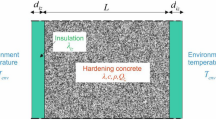Abstract
In the present work OPC and OPC/slag concretes were exposed to elevated temperatures, 400 and 800°C. The critical temperature of 400°C has been reported for OPC paste. Above 400°C, the paste hydrate Ca(OH)2 dehydrates into CaO causing the OPC paste to shrink and crack. After cooling and in the presence of air moisture, CaO rehydrates into Ca(OH)2, resulting in disintegration due to re-expansion of OPC paste. Therefore, the present work assessed whether this also applies to OPC concretes. Two cooling methods were used: furnace and water cooling. Following the heat treatment/cooling method, compressive tests and Infrared (IR) spectroscopic studies were conducted. Results showed that after 400°C, water cooling caused all concrete, regardless of the type of blended cement binder, a further 20% loss in the residual strength. After 800°C, water cooling caused OPC concrete a further 14% loss while slag blends presented around 5% loss. IR indicated that the further loss observed in the OPC concrete is due to the accelerated CaO rehydration into Ca(OH)2. Afterward, the non-wetted furnace cooled specimens were exposed to air moisture for one week, resulting in further strength loss of 13%. IR results suggested that slow rehydration of CaO occur with exposure to air moisture. In conclusion, water cooling caused more damage in OPC concrete, while the concrete that has not been wetted undergoes progressive deterioration. This indicates a need to monitor the non-wetted concrete after a fire event has occurred for potential further deterioration.







Similar content being viewed by others
References
Crozier DA, Sanjayan JG (1999) Chemical and physical degradation of concrete at elevated temperatures. Concrete in Australia, March–May, pp 18–20
Khoury GA (2000) Effect of fire on concrete and concrete structures. Prog Struct Eng Mater 2:429–447
Mendes A, Sanjayan J, Collins F (2008) Phase transformations and mechanical strength of OPC/Slag pastes submitted to high temperatures. Mater Struct 41:345–350
Mendes A, Sanjayan J, Collins F (2009) Long-term progressive deterioration following fire exposure of OPC versus slag blended cement pastes. Mater Struct 42:95–101
Lea FC, Stradling RE (1922) The resistance to fire of concrete and reinforced concrete. Engineering 144:341–344
Dias WPS, Khoury GA, Sullivan PJE (1990) Mechanical properties of hardened cement paste exposed to temperatures up to 700°C (1292 F). ACI Mater J 87:160–166
Noumowe A (2005) Mechanical properties and microstructure of high strength concrete containing polypropylene fibres exposed to temperatures up to 200°C. Cem Concr Res 35:2192–2198
Petzold A, Rohrs M (1970) Concrete for high temperatures, 2nd edn. Maclaren and Sons Ltd, London
Khoury GA (1992) Compressive strength of concrete at high temperatures: a reassessment. Mag Concr Res 44:291–309
Abramowicz M, Kowalski R (2005) The influence of short time water cooling on the mechanical properties of concrete heated up to high temperature. J Civil Eng Manag XI:85–90
Kowalski R (2007) The effects of the cooling rate on the residual properties of heated-up concrete. Struc Concr 8:11–15
Luo X, Sun W, Chan S (2000) Effect of heating and cooling regimes on residual strength and microstructure of normal strength and high performance concrete. Cem Concr Res 30:379–383
Nassif AY, Rigden S, Burley E (1999) The effects of rapid cooling by water quenching on the stiffness properties of fire-damaged concrete. Mag Concr Res 51:255–261
Sakr K, El-Hakim E (2005) Effect of high temperature or fire on heavy weight concrete properties. Cem Concr Res 35:590–596
Sarshar R (1989) Effect of elevated temperatures on the strength of different cement pastes and concretes. Department of Civil Engineering, University of London, London
Gosh SN (2002) Advances in cement technology—infrared spectroscopy in cement chemistry. Teck Books International, New Delhi
Gao XF, Lo Y, Tam CM, Chung CY (1999) Analysis of the infrared spectrum and microstructure of hardened cement paste. Cem Concr Res 29:805–812
Hanna RA, Barrie PJ, Cheeseman CR, Hills CD, Buchler PM, Perry R (1995) Solid state 29Si and 27Al NMR and FTIR study of cement pastes containing industrial wastes and organics. Cem Concr Res 25:1435–1444
Mollah MYA, Yu W, Schennach R, Cocke DL (2000) A Fourier transform infrared spectroscopy investigation of the early hydration of Portland cement and the influence of sodium lignosulfonate. Cem Concr Res 30:267–273
Australia Standard AS 3972-1997 Portland and blended cements
Chatterji S (2005) Aspects of generation of destructive crystal growth pressure. J Cryst Growth 277:566–577
Ramachandran VS, Sereda PJ, Feldman RF (1964) Mechanism of hydration of calcium oxide. Nature 201:288
Ramachandran VS, Sereda PJ, Feldman RF (1967) Discussion on ‘The volume expansion of hardened cement paste due to the presence of ‘dead burnt’ CaO’ by S Chatterji and J W Jeffrey. Mag Concr Res 19:49–50
Acknowledgment
The authors gratefully acknowledge the Australian Research Council Discovery Grant No. DP0558463 for this research project.
Author information
Authors and Affiliations
Corresponding author
Rights and permissions
About this article
Cite this article
Mendes, A., Sanjayan, J.G. & Collins, F. Effects of slag and cooling method on the progressive deterioration of concrete after exposure to elevated temperatures as in a fire event. Mater Struct 44, 709–718 (2011). https://doi.org/10.1617/s11527-010-9660-2
Received:
Accepted:
Published:
Issue Date:
DOI: https://doi.org/10.1617/s11527-010-9660-2




